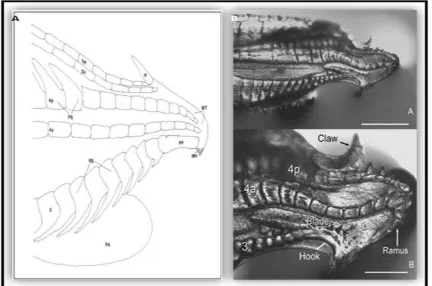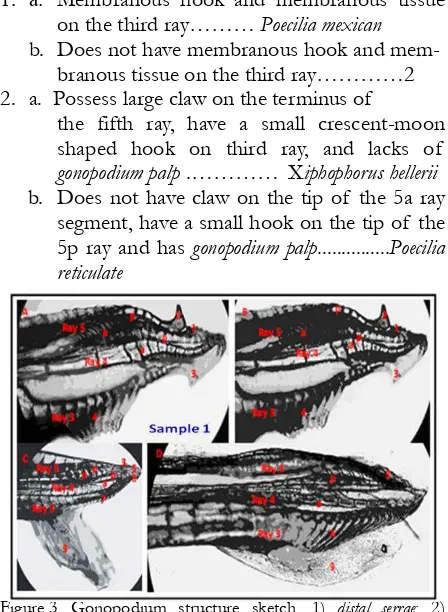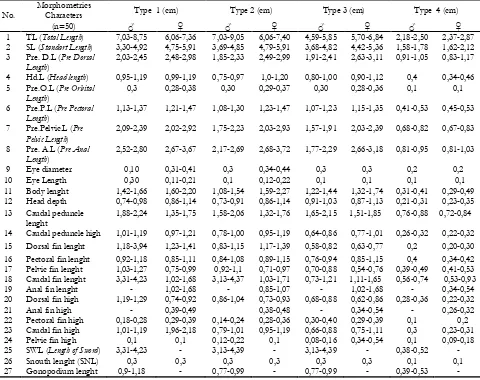Morphological Study to Improve Identification Toward Poeciliidae Family
Based on Gonopodium Structures and Morphometric Analysis
Dwi Anggorowati Rahayu1*, Dwi Listyorini2, Ibrohim2
1
Biology Department, Faculty of Mathematics and Natural Sciences, Brawijaya University, Malang, Indonesia 2
Biology Department, State University of Malang, Malang, Indonesia
ABSTRACT
Poeciliidae family consists of small livebearer fishes with sexual dimorphic. These fishes are widely distributed across Indonesian archipelago, but biological studies on these fishes are very limited. The research is aimed at identifing the species of Peciliidae fishes living in Lake Sari, Pasuruan, based on gonopodium structures and morphometric analysis. A specific characteristic of Poeciliidae family is that its gonopodium structures are a modification of the third, fourth, and fifth rays of the male’s anal fin. Each species are represented by 50 male and female samples from each type we found in the Lake, and they are measured in 26 characters (in mm). Cladogram based on morphometric measurements shows that sample 1 and 2 has 100 % similarity, sample 3 has 94 % similarity with sample 1 and 2, and sample 4 has 54 % similarity with sample 1, 2, and 3. Based on gonopodium structures , sample 1 and sample 2, included Xiphophorus hellerii Heckel, possess large claws on the terminus of the fifth ray, has a small crescent-moon shaped hook on the thirdray, and lacks of gonopodium palp. Sample 3 possesses a distal platform with 11 retrosse serrae, and membranous hook; so we were able to identify sample 3 as Poecilia mexicana Steindachner. Sample 4 is Poecilia reticulata Peter having a long-pointed, comb-like spines on the third ray, and having a small hook on the tip of the fifth ray.
Keywords: Identification, Poeciliidae family, morphometric analysis, gonopodium structures
INTRODUCTION
Fresh water fishes include the order of Cyprinodontiformes, among which is Poeciliidae family. The Poeciliidae family consists of fishes which are widely distributed throughout the world. The fertilization of this family is internal. Members of this family can be used as an object or a model for biological studies, such as ecolo-gy, embryoloecolo-gy, morpholoecolo-gy, physioloecolo-gy, and be-havioral study. Some members of the Poeciliidae family are able to control the spread of malaria by eliminating population of Anopheles larvae [1]. However, the systematic, diversity, and phy-logenetic relationship between the genus is not yet studied comprehensively [2].
Sari Lake which is located in the borderline between Purwodadi and Lawang, East Java, Indonesia, has such biodiversity abundance. There are many species of fishes found in this
*Corresponding address: Dwi Anggorowati Rahayu
Biology Department, Faculty of Mathematics and Natural Sciences, University of Brawijaya, Jalan Veteran, Malang, Indonesia 65145
E-mail: [email protected]
area. Among those species are fishes called gatul fish by the local people around Sari Lake area. Gatul fish in the Sari Lake have different mor-phological characteristics one to another, but their diversity have not known yet. Diversity knowledge is important to support information of biodiversity database of fishes in Indonesia.
Poeciliidae family consists of small fishes (4-20 cm total length). Their body is elongate to moderately deep. They have a flat head, a scaled and short snout, except in Belonesox. They have a wide, terminal, oblique, and protrusible mouth. These fishes have a single dorsal fin with 6 to 19 soft rays; their position are relative to anal fin variable. Their anal fin has nine soft rays. The third anal-fin ray is unbranched in males and fe-males. The caudal fin is round or emarginate. The pectoral fins have 9 to 16 soft, short, and rounded rays, and inserted high on the side of the body. The pelvic fins have 6 soft rays; sub-thoracic position in females and sub-thoracic posi-tion in adult males. Their body has large cycloid scales [3].
sys-JTLS |J. Trop. Life. Science 92 Volume 3 | Number 2 | May | 2013 tematic importance [4]. Members of Poeciliidae
are different in terms of gonopodium structures. These differences determine the genus and spe-cies [5]. Transfer of sperms into female reproduction tract is accomplished by a gonopodium, a generally highly modified anal fin. The anal fin of males is modified into a thin, elongate intromittent organ (gonopodium) which is not tubular, not scaled, and not enclosed as an extension of the sperm duct.
This paper decribes the characteristics of Poecilldae family based on gonopodium struc-ture and morphometric analysis. The description is important to understand the correlation of each type of Poeciliidae family found in Sari Lake.
MATERIAL AND METHODS
Morphological observations were done on 50 male and female samples from each type we found. We did very careful observation on the gonopodium structure, because it is one of the important keys to identify the genus and species level. We identified the gonopodium structures on the third, fourth, and fifth rays of the male’s anal fin from each type of male fish.
Figure 1. Gonopodium structure observation of Poeciliidae
The third rays of the gonopodium structure were claw, segment edge, retrose serrae, and gonopo-dium palp. The fourth rays of the gonopodium structure are ramus and distal serrae, 4 proximal serrae (p) rays gonopodium edge segment, proxi-mal serrae and the fifth rays are claw and hook, 5p ray and a sub distal gonopodium like in Figu-re 1 [4].
The morphometrics measurement included Total length (TL), Standard length (SL), Pre Dorsal Length (PreDL), Pre Orbital Length (PreOL), Pre Pectoral Length (PrePL), Pre Pelvic Length, Pre Anal Length (PreAL), Eye Length (EyeL), interobital length, depth of body, depth of head, length of
caudal peduncle, depth of caudal peduncle, length of dorsal fin, length of anal fin, length of pectoral fin, length of pelvic fin, length of caudal fin, length of sword, length of snout, height of dorsal fin, height of pectoral fin, height of caudal fin, height of pelvic fin, height of anal fin [6], and length of gonopodium [7].
Each species was represented by 50 male and female samples from each type we found and measured 26 characters (in mm). To standardize the different body sizes among the sample, each measurenment was divided by the SL (standard lenght) and converted to percentage. The con-verted data was transformed into log10 value be-fore being subjected to principal component ana-lyses and clustering anaana-lyses based on Euclidean distances using PAST software.
RESULTS AND DISSCUSSION
A specific characteristic of the Poeciliidae is on its gonopodium structures, that is modifica-tion of the third, fourth, and fifth rays of the male’s anal fin. Sample 1 and 2 (Figure 2A and B), possess large claw on the terminus of the fifth ray (orange arrow), have a small crescent-moon shaped hook on third ray (green arrow), and lack of gonopodium palp (blue arrow). Compa-red to sample 1 and 2, sample 3 and 4 possess a gonopodium palp (blue arrow). Sample 3 (Figure 2C) possesses a distal platform with 11 retrosse serrae (purple arrow), membranous hook (red arrow), and well developed membranous tissue on the third ray around the distal tip (light green arrow). Sample 4 (Figure 2D) has a long-pointed comb-like spines on the third ray (white arrow), and has a small hook on the tip of 5p ray (pink arrow).
Identification key of Poeciliidae family
Based on morphological characteristics (morphometric and gonopodium structure), we concluded this characters into identifications key of this family:
1. a. Membranous hook and membranous tissue on the third ray……… Poecilia mexican b. Does not have membranous hook and
mem-branous tissue on the third ray…………2 2. a. Possess large claw on the terminus of
the fifth ray, have a small crescent-moon shaped hook on third ray, and lacks of gonopodium palp .………… Xiphophorus hellerii b. Does not have claw on the tip of the 5a ray
segment, have a small hook on the tip of the 5p ray and has gonopodium palp...Poecilia reticulate
Figure 3. Gonopodium structure sketch, 1) distal serrae; 2) claw; 3) hook; 4) comb; 5) membranous tissue; 6) blade; 7) retrose serrae; 8) membranous hook; 9)
gonopodium palp; 10) cephalic ramus; 11) distal platform
Based on those gonopodium characters, we propose to classify these samples in a hierarchy as follows [5]:
Kingdom : Animalia Phylum : Chordata Class : Actinopterygii Ordo : Cyprinodontiformes Family : Poeciliidae
Sub-family : Poeciliinae
Genus : Xiphophorus (sample 1 and 2) Poecilia (sample 3 and 4)
Species : X. hellerii Heckel (sample 1 and 2) P. mexicana Steindachner (sample 3) P. reticulata Peter (sample 4)
The most common morphological characters of the fish species studied are that they have a single dorsal fin with soft rays, anal fin rays on the female mounted A9, three rays are not branched with anal fin, pelvic fin rays have V6, indicating sexual dimorfism of the body size and color pattern, and have cycloid scales. These characters indicate that these fishes actually are
Figure 4. Dendogram based on morphometric characters in Sari Lake, Purwodadi, Pasuruan
members of Poeciliidae [1].
Cladogram based on morphometric measure-ments showed that X. hellerii (orange) and X. hellerii (grey) have 100 % similarity, P. mexicana has 94 % similarity with orange and grey X. hellerii. P. reticulata has 54 % similarity with the others. The dendogram based on Euclidian dis-tance shows that the Poeciliidae can be divided into two clusters, the X. hellerii group and the second cluster was divided into two sub-clusters (Figure 4). This clustering was based on data which derived from 26 characters measurements (Table 1, supplement 1).
The male and female fishes have different body color patterns. Sexual dimorfi in color pat-tern follows the character of Poeciliidae. Type 1 has a lot of carotenoids pigment (orange), type 2 has a lot of melanocytes pigment (grey), and type 3 has a lot of carotenoid pigments in the body with orange spots on the abdominal area and neatly arranged rows in antero-posterior part of the body. The character of color pattern is si-miliar to Poecilia (Mollenesia) rositae [8]. Type 4 has melanocytes pigment in the females, while the males have yellow, black, and metallic pig-ment creating different spots. There is a black-spotted color pattern for the members of Poecilia, Poeciliidae family, as well as on the species of P. reticulate—each has a black spot on the body of the male fish. These colors are indeed owned by the members of Poecilia, such as Poecilia wingei and P. reticulata [9].
CONCLUSSION
JTLS |J. Trop. Life. Science 94 Volume 3 | Number 2 | May | 2013 similarity; sample 3 had 94 % similarity with
sample 1 and 2; and sample 4 had 54 % similarity with sample 1, 2, and 3.
REFERENCES
1. Ghedotii MJ (2005) Phylogenetic analysis and
taxonomy of the Poeciliid fishes
(Cyprinodontiformes: Teleostei). Zoological
Journal of the Linnean Society 130: 1-53.
2. Lucinda PHF (2003) Family Poeciliidae, check
list of the freshwater fishes of South and Central America. Neotropical Ichtiology 3: 3.
3. Meyer MK, Radda AC (2000) Notes on the
Subgenus Mollienesia LeSueur, 1821, with a description of a new species of Poecilia Bloch and
Scheinder, 1801 (Cyprinodontiformes:
Poeciliidae) from Venezuela. Ann Naturhist, 102B: 75-81.
4. Regan CT (1913) Revision of the cyprinodont
fishes of the subfamily Poecilinae. Proc. Zool. Sec.Lond. 11: 977-1018.
5. Hrbek T, Seckinger J, Meyer A (2006) A
phylogenetic and biogeographic prespective on the evolution of Poeciliid fishes. Molecular Phylogenetics and Evolution 43: 986-998.
6. Maurice K, Whitten AJ, Kartikasari SN,
Wirjoatmodjo S (1993) Ikan air tawar Indonesia bagian barat dan Sulawesi. Periplus Edition. Jakarta.
7. Meyer MK, Schneider K, Radda AC, Wilde B,
Schartl M (2004) A new species of Poecilia, subgenus Mollienesia, from Upper Rio Cahabon System, Guatemala, with remarks on the no-menclature of Mollienesia petenensis Gunter, 1866
(Teleostei: Cyprinodontiformes: Poeciliidae).
Zoologische Abhandlungen, 54: 145-154.
8. Meyer MK, Schories S, Schartl M (2010)
Description of Gambusia zarskei sp.n.-a new
Poeciliid fish from the Upper Rio Conchos
system, Chicuchua, Mexico (Teleostei:
Cyprinodontiformes: Poeciliidae). Vertebrate
Zoology 60: 11-18.
9. Poeser FN, Kempkes M, Isbrücker IJH (2005)
Supplement 1
Table 1. Morphometric measurenments of Poeciliidae family
No.
Morphometrics
Characters Type 1 (cm) Type 2 (cm) Type 3 (cm) Type 4 (cm)
(n=50) ♂ ♀ ♂ ♀ ♂ ♀ ♂ ♀
1 TL (Total Length) 7,03-8,75 6,06-7,36 7,03-9,05 6,06-7,40 4,59-5,85 5,70-6,84 2,18-2,50 2,37-2,87
2 SL (Standart Length) 3,30-4,92 4,75-5,91 3,69-4,85 4,79-5,91 3,68-4,82 4,42-5,36 1,58-1,78 1,62-2,12
3 Pre. D.L (Pre Dorsal Length)
2,03-2,45 2,48-2,98 1,85-2,33 2,49-2,99 1,91-2,41 2,63-3,11 0,91-1,05 0,83-1,17
4 Hd.L (Head length) 0,95-1,19 0,99-1,19 0,75-0,97 1,0-1,20 0,80-1,00 0,90-1,12 0,4 0,34-0,46
5 Pre.O.L (Pre Orbital Length)
0,3 0,28-0,38 0,30 0,29-0,37 0,30 0,28-0,36 0,1 0,1
6 Pre.P.L (Pre Pectoral Length)
1,13-1,37 1,21-1,47 1,08-1,30 1,23-1,47 1,07-1,23 1,15-1,35 0,41-0,53 0,45-0,53
7 Pre.Pelvic.L (Pre Pelvic Length)
2,09-2,39 2,02-2,92 1,75-2,23 2,03-2,93 1,57-1,91 2,03-2,39 0,68-0,82 0,67-0,83
8 Pre. A.L (Pre Anal Length)
2,52-2,80 2,67-3,67 2,17-2,69 2,68-3,72 1,77-2,29 2,66-3,18 0,81-0,95 0,81-1,03
9 Eye diameter 0,10 0,31-0,41 0,3 0,34-0,44 0,3 0,3 0,2 0,2
10 Eye Length 0,30 0,11-0,21 0,1 0,12-0,22 0,1 0,1 0,1 0,1
11 Body lenght 1,42-1,66 1,60-2,20 1,08-1,54 1,59-2,27 1,22-1,44 1,32-1,74 0,31-0,41 0,29-0,49
12 Head depth 0,74-0,98 0,86-1,14 0,73-0,91 0,86-1,14 0,91-1,03 0,87-1,13 0,21-0,31 0,23-0,35
13 Caudal peduncle lenght
1,88-2,24 1,35-1,75 1,58-2,06 1,32-1,76 1,65-2,15 1,51-1,85 0,76-0,88 0,72-0,84
14 Caudal peduncle high 1,01-1,19 0,97-1,21 0,78-1,00 0,95-1,19 0,64-0,86 0,77-1,01 0,26-0,32 0,22-0,32
15 Dorsal fin lenght 1,18-3,94 1,23-1,41 0,83-1,15 1,17-1,39 0,58-0,82 0,63-0,77 0,2 0,20-0,30
16 Pectoral fin lenght 0,92-1,18 0,85-1,11 0,84-1,08 0,89-1,15 0,76-0,94 0,85-1,15 0,4 0,34-0,42
17 Pelvic fin lenght 1,03-1,27 0,75-0,99 0,92-1,1 0,71-0,97 0,70-0,88 0,54-0,76 0,39-0,49 0,41-0,53
18 Caudal fin lenght 3,31-4,23 1,02-1,68 3,13-4,37 1,03-1,71 0,73-1,21 1,11-1,65 0,56-0,74 0,53-0,93
19 Anal fin lenght - 1,02-1,68 - 0,85-1,07 - 1,02-1,68 - 0,34-0,54
20 Dorsal fin high 1,19-1,29 0,74-0,92 0,86-1,04 0,73-0,93 0,68-0,88 0,62-0,86 0,28-0,36 0,22-0,32
21 Anal fin high - 0,39-0,49 0,38-0,48 - 0,34-0,54 - 0,26-0,32
22 Pectoral fin high 0,18-0,28 0,29-0,39 0,14-0,24 0,28-0,36 0,30-0,40 0,29-0,39 0,1 0,2
23 Caudal fin high 1,01-1,19 1,96-2,18 0,79-1,01 0,95-1,19 0,66-0,88 0,75-1,11 0,3 0,23-0,31
24 Pelvic fin high 0,1 0,1 0,12-0,22 0,1 0,08-0,16 0,34-0,54 0,1 0,09-0,18
25 SWL (Length of Sword) 3,31-4,23 - 3,13-4,39 - 3,13-4,39 - 0,38-0,52 -
26 Snouth lenght (SNL) 0,3 0,3 0,3 0,3 0,3 0,3 0,1 0,1


